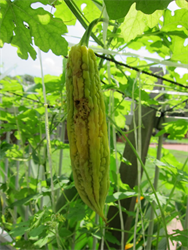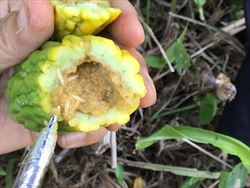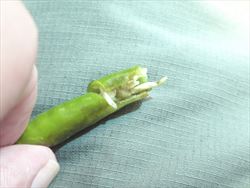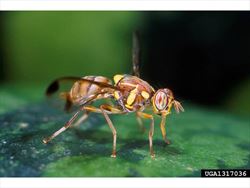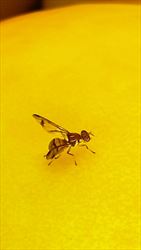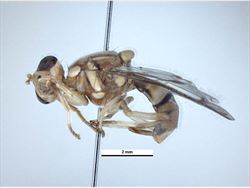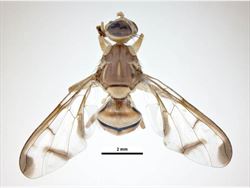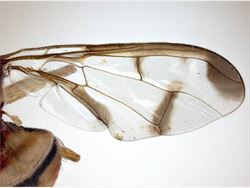- Widespread. Australia (Queensland), Guam, Kiribati, Nauru, MNI, PNG, Solomon Islands.
- Major invasive pest of cucumber family, also Solanum crops.
- Eggs (plus fruit fly-beneficial bacteria) laid in flowers and fruits giving a characteristic ‘sting’. Bacteria rot flesh providing food for maggots, and fruits usually fall to groundwhere larvae pupate. Adults, size of slender large house fly, bright yellow markings on thorax, T-shaped mark on abdomen, and smoky-brown marks at wing tips and back of wings along veins. Life cycle 3-5 weeks. Adults survive many weeks.
- Spread on the wing (moderately strong flier), and as larvae in infested fruit.
- Natural enemies: Psyttalia fletcheri (from India to Hawaii) - moderate mortality in Momordica, limited in cultivated fruit.
- Biosecurity: technologies and schemes to facilitate trade, including:
- post-harvest measures: HTFA (high temperature forced air); low temperature; insecticide dips; irradiation.
- area freedom, or area-wide management.
- consider in-country quarantines where melon fly is not widespread, or where countries free from melon fly border those infested.
- Cultural control: (i) monitor – trap male flies with pheromone (cure-lure); regularly check ripe fruit; (ii) protein baits – use yeast autolysate and insecticide as a spot spray; (iii) hygiene – bag fruit; harvest early; pick up fallen fruit, and remove those damaged but still on the crop, and destroy; (iv) crop rotation; (v) destroy remains of harvest.
- Eradication: define quarantine area; control fruit movement; remove fruit from trees and collect fallen fruit, protein bait/insecticide sprays; male annihilation; possibly SIT (sterile insect technique).
- Chemical control: protein bait (yeast hydrolysate) plus insecticide.
Pacific Pests, Pathogens and Weeds - Online edition
Pacific Pests, Pathogens, Weeds & Pesticides
Melon fly (505)
Melon fly
Zeugodacus cucurbitae; known previously as Bactrocera (Zeugodacus) cucurbitae, and Bactrocera cucurbitae.
AUTHORS Graham Walker & Grahame Jackson
Information from Allwood AJ, et al. (1999) Host plant records for fruit flies (Diptera: Tephritidae) in South-East Asia. The Raffles Bulletin of Zoology. Supplement 7. 92 pp. (Complete host list in Asia); and Allwood AJ, Drew RAI (1997) Management of fruit flies in the Pacific. ACIAR Proceedings No 76. 267pp.; and Melon fruit fly (Undated) Fact sheet. Plant Health Australia. (https://www.planthealthaustralia.com.au/wp-content/uploads/2013/09/Melon-fruit-fly-FS.pdf); and Anon (2020) Melon fly. Business Queensland. Queensland Government. (https://www.business.qld.gov.au/industries/farms-fishing-forestry/agriculture/crop-growing/priority-pest-disease/melon-fly); and The Australian Handbook for the Identification of Fruit Flies (2018) Plant Health Australia. Canberra, ACT. (Version. 3.1). (https://www.planthealthaustralia.com.au/wp-content/uploads/2018/10/The-Australian-Handbook-for-the-Identification-of-Fruit-Flies-v3.1.pdf); and Waterhouse DF (1993) Pest fruit flies in the oceanic Pacific. Biological Control Pacific Prospects - Supplement 2. ACIAR, Canberra; and Garcia FRM, et al. (2020). Biological control of tephritid fruit flies in the Americas and Hawaii: A review of the use of parasitoids and predators. Insects 11(10): 662. (https://pubmed.ncbi.nlm.nih.gov/32993000/); and from Yates. Fruit fly control in your garden (https://www.yates.com.au/plants/problem-solver/pests/fruit-fly/). Photo 1 Melon Fly (Zeugodacus cucurbitaceae). Scott Bauer, USDA Agricultural Research service, Bugwood.org. Photos 7-10 Walker K (2006) Melon Fruit Fly (Bactrocera cucurbitae). Museum of Victoria. PaDIL - http://www.padil.gov.au. Diagram McDougall S, et al. (2013). Tomato, capsicum, chilli and eggplant: A field guide for the identification of insect pests, beneficials, diseases and disorders in Australia and Cambodia. Australian Centre for International Agricultural Research (ACIAR). (http://aciar.gov.au/files/mn-157/index.html).
Produced with support from the Australian Centre for International Agricultural Research under project HORT/2016/185: Responding to emerging pest and disease threats to horticulture in the Pacific islands, implemented by the University of Queensland and the Secretariat of the Pacific Community.

